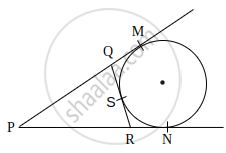Advertisements
Advertisements
Question
Prove that opposite sides of a quadrilateral circumscribing a circle subtend supplementary angles at the centre of the circle.
Solution 1
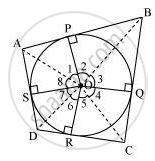
Let ABCD be a quadrilateral circumscribing a circle centred at O such that it touches the circle at point P, Q, R, and S. Let us join the vertices of the quadrilateral ABCD to the centre of the circle.
Consider ΔOAP and ΔOAS,
AP = AS .....(Tangents from the same point)
OP = OS ..... (Radii of the same circle)
OA = OA ....(Common side)
ΔOAP ≅ ΔOAS .... (SSS congruence criterion)
Therefore, A ↔ A, P ↔ S, O ↔ O
And thus, ∠POA = ∠AOS
∠1 = ∠8
Similarly,
∠2 = ∠3
∠4 = ∠5
∠6 = ∠7
∠1 + ∠2 + ∠3 + ∠4 + ∠5 + ∠6 + ∠7 + ∠8 = 360º
(∠1 + ∠8) + (∠2 + ∠3) + (∠4 + ∠5) + (∠6 + ∠7) = 360º
2∠1 + 2∠2 + 2∠5 + 2∠6 = 360º
2(∠1 + ∠2) + 2(∠5 + ∠6) = 360º
(∠1 + ∠2) + (∠5 + ∠6) = 180º
∠AOB + ∠COD = 180º
Similarly, we can prove that ∠BOC + ∠DOA = 180º
Hence, opposite sides of a quadrilateral circumscribing a circle subtend supplementary angles at the centre of the circle.
Solution 2
Let ABCD be a quadrilateral circumscribing a circle with centre at O.
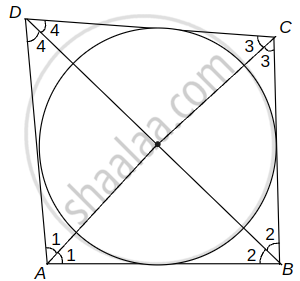
Join OA, OB, OC and OD.
Here, Let ∠DAO = ∠BAO = ∠1 ...[∵ AB and AD are tangents]
Similarly, ∠ABO = ∠CBO = ∠2 ...[∵ BA and BC are tangents]
And Let ∠BCO = ∠DCO = ∠3 ...[∵ CB and CD are tangents]
And Let ∠CDO = ∠ADO = ∠4 ...[∵ DC and DA are tangents]
Sum of all angles at the centre is 360°.
Also, the sum of the angles in quadrilateral, ABCD = 360°
∴ 2(∠1 + ∠2 + ∠3 + ∠4) = 360°
⇒ ∠1 + ∠2 + ∠3 + ∠4 = 180° ...(i)
Now, In ΔAOB,
∠AOB = 180° – (∠1 + ∠2) ...(ii)
In ΔCOD, ∠COD = 180° – (∠3 + ∠4) ...(iii)
On adding equations (ii) and (iii), we get
∠AOB + ∠COD = 360° – (∠1 + ∠2 + ∠3 + ∠4)
= 360° – 180°
= 180° ... [From equation (i)]
Since AB and CD subtend supplementary angles at O.
Thus, opposite sides of a quadrilateral circumscribing a circle subtend supplementary angles at the centre of the circle.
APPEARS IN
RELATED QUESTIONS
The length of a tangent from a point A at distance 5 cm from the centre of the circle is 4 cm. Find the radius of the circle.
In the given figure, AD is a diameter. O is the centre of the circle. AD is parallel to BC and ∠CBD = 32°.
Find:
- ∠OBD
- ∠AOB
- ∠BED
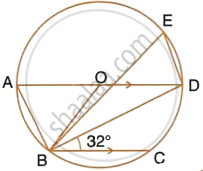
Find the angle between two radii at the centre of the circle as shown in the figure. Lines PA and PB are tangents to the circle at other ends of the radii and ∠APR = 140°.
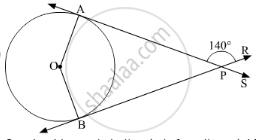
A right circular cone is divided into three parts by trisecting its height by two planes drawn parallel to the base. Show that the volumes of the three portions starting from the top are in the ratio 1 : 7 : 19 ?
In Fig. 2, from a point P, two tangents PT and PS are drawn to a circle with centre O such that ∠SPT = 120°, Prove that OP = 2PS ?
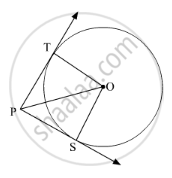
In Figure 1, a quadrilateral ABCD is drawn to circumscribe a circle such that its sides AB, BC, CD and AD touch the circle at P, Q, R and S respectively. If AB = x cm, BC = 7 cm, CR = 3 cm and AS = 5 cm, find x.

(A) 10
(B) 9
(C) 8
(D) 7
In the given circle with center o, ∠ABC=100°, ∠ACD=40° and CT is tangent to the circle at C. find ∠ADC and ∠DCT.

M and N are the midpoints of chords AB and CD . The line MN passes through the centre O . Prove that AB || CD.
In the given figure, PQ is a tangent to the circle at A. AB and AD are bisectors of ∠CAQ and ∠PAC. If ∠BAQ = 30°, prove that : BD is diameter of the circle.
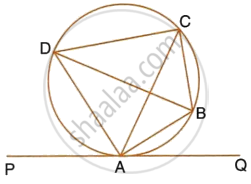
In the given figure, AD is a diameter. O is the centre of the circle. AD is parallel to BC and ∠CBD = 32°.
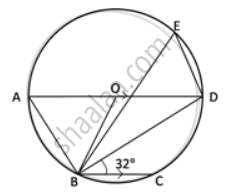
Find: ∠BED
In the following figure, Q is the centre of a circle and PM, PN are tangent segments to the circle. If ∠MPN = 60°, find ∠MQN.
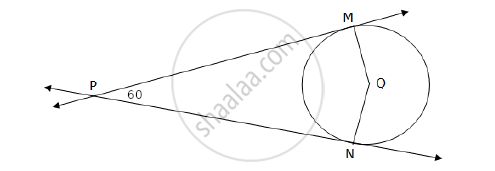
In Fig. 4, a circle is inscribed in a ΔABC having sides BC = 8 cm, AB = 10 cm and AC = 12 cm. Find the lengths BL, CM and AN.

Two concentric circles of radii a and b (a > b) are given. Find the length of the chord of the larger circle which touches the smaller circle.
Construct a pair of tangents to a circle of radius 4 cm from a point which is at a distance of 6 cm from its centre.
The number of tangents drawn at a point of the circle is/are ______
In the given figure, CP and CQ are tangents to a circle with centre O. ARB is another tangent touching the circle at R. If CP = 11 cm and BC = 6 cm then the length of BR is ______

The length of tangent from an external point P on a circle with centre O is always less than OP.
From an external point P, two tangents, PA and PB are drawn to a circle with centre O. At one point E on the circle tangent is drawn which intersects PA and PB at C and D, respectively. If PA = 10 cm, find the the perimeter of the triangle PCD.
Draw two concentric circles of radii 2 cm and 3 cm. From a point on the outer circle, construct a pair of tangents to the inner circle.
In the given figure, if a circle touches the side QR of ΔPQR at S and extended sides PQ and PR at M and N, respectively, then prove that PM = `1/2` (PQ + QR + PR)
